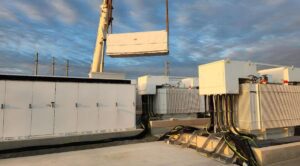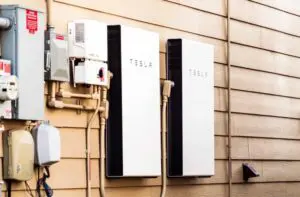The Waratah Super Battery, the biggest unit of any technology to be connected to the Australian grid, set a grid output record for a big battery this week, as its owners snapped up staff laid off by its newly bankrupted battery supplier.
The Waratah battery, designed to act as a kind of giant “shock absorber” to the grid, will be sized at 850 MW and 1680 MWh.
While the storage number will be overtaken quickly enough by the two giant batteries being built at Collie in Western Australia – both rated at 2,000 MWh or more – its 850 MW capacity makes it the most powerful machine of any type to send power to the grid.
On Tuesday, on multiple occasions in the middle of the day, it sent up to 369 MW to the grid – the limit allowed at its newly attained “hold point 3” – part of the process of working through the lengthy commissioning process.
For good measure, the Waratah Super Battery also charged at a rate of up to 369 MW soon after as part of its testing. These numbers are higher than the rated capacity of the current biggest battery on Australia’s grid, the 300 MW, 450 MWh Victoria Big Battery, built by Neoen and soon to be owned by HMC Capital.

The Waratah Super Battery was originally scheduled to be finished by the end of March, in time for the anticipated closure of the nearby Eraring coal generator, the country’s biggest at 2.88 gigawatts in August this year.
Waratah has a 5.5 year contract to reserve the bulk of its capacity to act as a kind of giant “shock absorber”, allowing the big transmission lines feeding into the main load centres in Sydney, Newcastle and Wollongong to operate at greater capacity.
But the closure of Eraring has been delayed for at least two years, after a deal struck by a NSW state government anxious not to be caught short of power or battered by high wholesale electricity prices, and the timeline for Waratah was allowed to slip – first to August and more recently to the end of the year.
Owner Akaysha Energy has cited bad weather, and heavy rains, for the delays, although the battery obtained its grid registration in good time last year and even made a surprising appearance when called up as an emergency reserve by the market operator in November.
Since then, however, there have been issues with the commissioning process – not uncommon in Australia given the complexity of rules on the main grid – or given the size of this project.
And last week Powin, its US-based battery supplier, added to the complexity by filing for bankruptcy protection, having flagged a potential collapse late last month.
Akaysha says, however, that the collapse of Powin has had minimal impact on its project – the company has also supplied the batteries at the smaller Ulinda Park battery project in Queensland – as the batteries had already been installed.
Akaysha managing director Nick Carter, however, has been in Oregon, Powin’s home base, snapping up Powin staff, including software engineers Bora Akyol, Anna Zybina and Zeke Rogers, and development ops engineers Doug King and William Krause.

Carter said on LinkedIn that he also had the opportunity this week to speak about the Powin issues and the Waratah battery to prime minister Anthony Albanese and Australian ambassador to the US Kevin Rudd, as they came through Seattle en route to the G7 conference in Canada.
The Waratah battery will need to work its way through at least another two hold points in coming months as it seeks to complete the commissioning process. There is no word on how the delays, and the extended closure date for Eraring, will affect its contracts with EnergyCo, the details of which have not been released.







